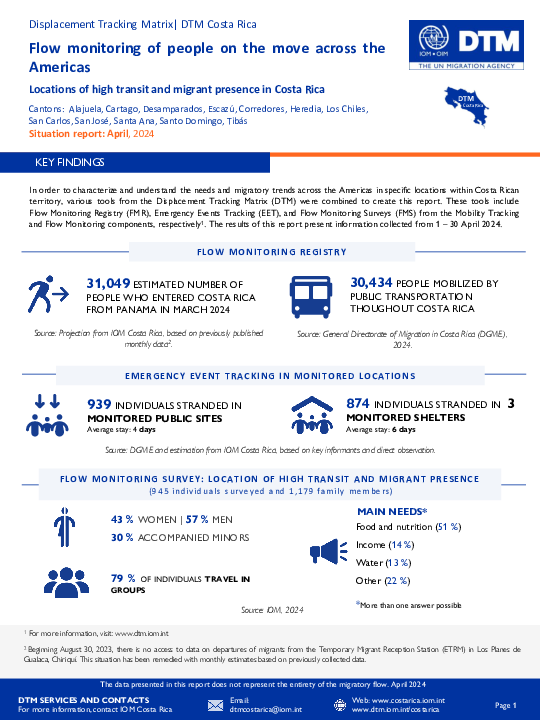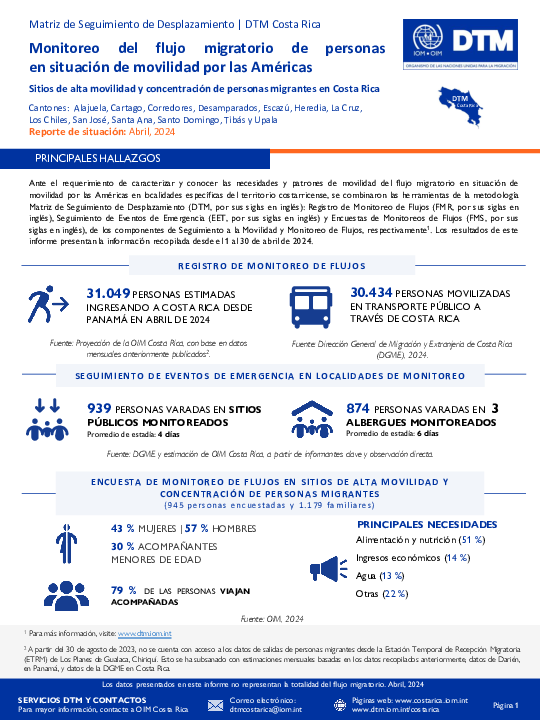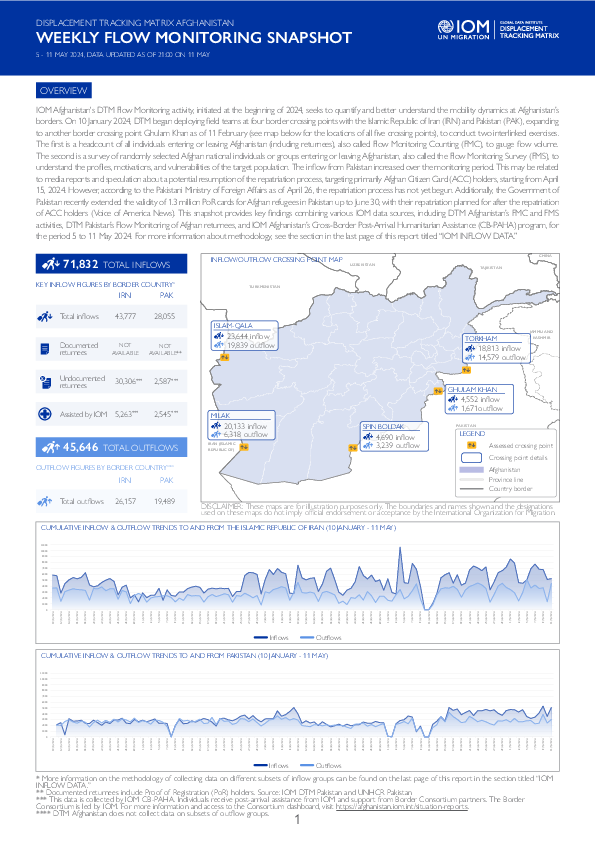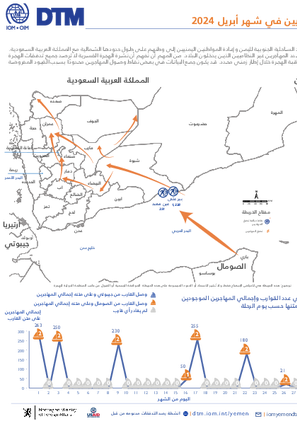-
Countries
-
Data and Analysis
-
Special Focus
-
Crisis Responses
Flow Monitoring

Contact
DTMCostaRica@iom.int
Language
English
Location
Costa Rica
Period Covered
Apr 01 2024
Apr 30 2024
Activity
- Flow Monitoring
- Mobility Tracking
- Event Tracking
Cantons: Alajuela, Alajuelita, Cartago, Desamparados, Escazú, Corredores, Heredia, Los Chiles, San Carlos, San José, Santa Ana, Santo Domingo, Tibás
Costa Rica, like the other countries in the Central American region, has been characterized as a migratory corridor for people who transit by land from the south to the north of America and whose destination is the countries in the north of the continent. This flow on the move through the Americas is mainly made up of people from the Bolivarian Republic of Venezuela, Cuba, Haiti, Ecuador, as well as people from other countries in South America, Africa and Asia.
According to estimations from IOM Costa Rica, during April 31,049 people entered the country, an approximate average of 1,035 people per day and estimating a decrease of 14% compared to March 2024. In addition, 874 people stranded in the monitored shelters were identified and 939 people stranded in the public places visited.

Contact
Angélica Madrigal amadrigal@iom.int
Language
English
Location
Costa Rica
Period Covered
Apr 01 2024
Apr 30 2024
Activity
- Survey
- Registration
- Flow Monitoring
Cantones: Alajuela, Alajuelita, Cartago, Desamparados, Escazú, Corredores, Heredia, Los Chiles, San Carlos, San José, Santa Ana, Santo Domingo, Tibás
Costa Rica, al igual que los demás países de la región centroamericana, se ha caracterizado por ser un corredor migratorio para personas que transitan de manera terrestre desde el sur hasta el norte de América y que tienen como destino los países del norte del continente. Este flujo en situación de movilidad por las Américas se encuentra compuesto principalmente por personas de la República Bolivariana de Venezuela, Cuba, Haití, Ecuador, así como personas provenientes de otros países de Suramérica, África y Asia.
Según estimaciones de la OIM Costa Rica, durante abril ingresaron al país 31.049 personas, un promedio aproximado de 1.035 personas por día y estimando una disminución de un 14% con respecto a marzo de 2024. Además, se identificaron 874 personas varadas en los albergues monitoreados y 939 personas varadas en los sitios públicos visitados.

Contact
DTMAfghanistan@iom.int
Language
English
Location
Afghanistan
Period Covered
May 05 2024
May 11 2024
Activity
- Survey
- Flow Monitoring Survey
- Flow Monitoring
IOM Afghanistan's DTM Flow Monitoring activity, initiated at the beginning of 2024, seeks to quantify and better understand the mobility dynamics at Afghanistan’s borders. On 10 January 2024, DTM began deploying field teams at four border crossing points with the Islamic Republic of Iran (IRN) and Pakistan (PAK), expanding to another border crossing point Ghulam Khan as of 11 February (see map below for the locations of all five crossing points), to conduct two interlinked exercises. The first is a headcount of all individuals entering or leaving Afghanistan (including returnees), also called Flow Monitoring Counting (FMC), to gauge flow volume. The second is a survey of randomly selected Afghan national individuals or groups entering or leaving Afghanistan, also called the Flow Monitoring Survey (FMS), to understand the profiles, motivations, and vulnerabilities of the target population. The inflow from Pakistan increased over the monitoring period. This may be related to media reports and speculation about a potential resumption of the repatriation process, targeting primarily Afghan Citizen Card (ACC) holders, starting from April 15, 2024. However, according to the Pakistani Ministry of Foreign Affairs as of April 26, the repatriation process has not yet begun. Additionally, the Government of Pakistan recently extended the validity of 1.3 million PoR cards for Afghan refugees in Pakistan up to June 30, with their repatriation planned for after the repatriation of ACC holders (Voice of America News). This snapshot provides key findings combining various IOM data sources, including DTM Afghanistan’s FMC and FMS activities, DTM Pakistan’s Flow Monitoring of Afghan returnees, and IOM Afghanistan’s Cross-Border Post-Arrival Humanitarian Assistance (CB-PAHA) program, for the period 5 to 11 May 2024. For more information about methodology, see the section in the last page of this report titled “IOM INFLOW DATA.”
This report presents the main findings from the Displacement Tracking Matrix (DTM) Flow Monitoring Surveys (FMS) deployed in Greece, Italy, and Spain in 2023. FMS provide a snapshot of the profiles, experiences, and needs of migrants. The survey asks questions on demographics, education and employment backgrounds, the circumstances of the migration journey and migration factors, as well as future intentions and vulnerabilities to abuse, exploitation and violence.
In 2023, a total of 4,020 surveys were collected in 130 entry and transit points for migrants arriving by land and by sea to Europe. The report explores similarities and differences among migrants travelling along the Eastern Mediterranean Route (EMR), the Central Mediterranean Route (CMR), the Western Mediterranean Route (WMR) and the Western African Atlantic Route (WAAR) (3,626 surveys). A separate section also looks at the evidence from migrants interviewed in the North of Italy, entering by land from Slovenia (394), connecting this with analyses carried out in the Western Balkan (WB) region. A final section addresses the conditions and needs of migrant children (14-17 years old) in the sample.
This snapshot on nationals from Pakistan in Europe is part of the outputs of IOM’s EU-funded Displacement Tracking Matrix - Regional Evidence for Migration Analysis and Policy (DTM REMAP) project. The snapshot is divided into three sections:
Firstly, it provides information on the number of Pakistani nationals who arrived by land and sea in Europe and those who transited through the Western Balkan and Eastern Europe region in 2023. The data on arrivals and transits is made available by national authorities and then gathered by the IOM DTM team in Europe.
Secondly, it delves into the demographic distribution of Pakistani nationals residing in Europe, categorized by gender and geographical regions within Europe, utilizing data reported by Eurostat and the UK Office of Statistics.
Lastly, the report encapsulates the insights gained from the Flow Monitoring Survey (FMS) conducted by the DTM Europe team, engaging with 373 Pakistani nationals across seven European countries throughout 2023.

Contact
DTM Europe, DTMMediterranean@iom.int
Language
English
Location
Italy
Period Covered
Aug 04 2023
Dec 27 2023
Activity
- Survey
- Flow Monitoring
This report presents the results of the Displacement Tracking Matrix (DTM) Flow Monitoring Surveys (FMS) deployed in Italy in 2023. The data were collected from 04 August to 27 December 2023 in three Italian regions (Calabria, Friuli Venezia Giulia, and Sicily).
IOM interviewed a total of 1,451 individual respondents. FMS provide a snapshot of the profiles, experiences, and needs of migrants. The survey asks questions on demographics, education and employment backgrounds, the circumstances of the migration journey and migration factors, as well as future intentions and vulnerabilities to abuse, exploitation and violence.

Contact
DTM Nigeria, iomnigeriadtm@iom.int
Language
English
Location
Nigeria
Period Covered
Mar 01 2024
Mar 31 2024
Activity
- Flow Monitoring
This report presents the data for the month of March 2024, collected through direct interviews and direct observation by DTM enumerators and triangulated via a network of key informants. It highlights the number of herders and their herds identified at 16 counting points. Notably, this enumeration included areas within the Kachia, Kaura, Kaita, and Faskari Local Government Areas (LGAs) of Kaduna and Katsina states, under the auspices of the Peacebuilding Fund. Additionally, it extended to Batsari, Jibia, Kankara, and Dan Musa LGAs of Katsina state, which
were supported by the European Union Fund.
In March 2024, Transhumance Flow Monitoring tool identified 1,322 herders in Kaduna State and 197 herders in Katsina State. The animal count was estimated at 43,772 for Kaduna State and 5,013 for Katsina State. Notably, 97 per cent of the total number of herders departed from states within Nigeria, while the remaining 3 per cent departed from Niger.

Contact
DTM Nigeria, iomnigeriadtm@iom.int
Language
English
Location
Nigeria
Period Covered
Feb 01 2024
Feb 29 2024
Activity
- Flow Monitoring
This report presents the data for the month of February 2024, collected through direct interviews and direct observation by DTM enumerators and triangulated via a network of key informants. It highlights the number of herders and their herds identified at 34 counting points. Notably, this enumeration included areas within the Kachia, Kaura, Kaita, and Faskari Local Government Areas (LGAs) of Kaduna and Katsina states, under the auspices of the Peacebuilding Fund. Additionally, it extended to Batsari, Jibia, Kankara, and Dan Musa LGAs of Katsina State, which were supported by the European Union Fund.
In February 2024, Transhumance Flow Monitoring tool identified 1,423 herders in Kaduna State and 600 herders in Katsina State. The animal count was estimated at 55,211 for Kaduna State and 13,684 for Katsina State. Notably, 91 per cent of the total number of herders departed from states within Nigeria, while the remaining 9 per cent departed from Niger.
Contact
iomyemendtm@iom.int
Location
Yemen
Activity
- Flow Monitoring
Period Covered
Apr 01 2024 -Apr 30 2024
In April 2024, the IOM Yemen DTM reported 1,479 migrants entering Yemen, a 23 percent decrease from the total figure reported in the previous month (1,930 migrants). All migrants left from Bari region in Somalia (1,479) and arrived in Shabwah governorate in Yemen, which typically serves as a key entry point for migrants leaving Somalia. Moreover, migrants leaving from Djibouti rarely choose Shabwah due to the significant distance between the two locations.
Although all migrants arrived through Shabwah coastal area, the number of migrants entering through same area decreased by 18 per cent in April (1,479) compared to March 2024 (1,800). Among the total migrants recorded, 22 per cent were children, 15 per cent were women, and 63 per cent were men. According to data collected for April 2024, 74 per cent of migrants stated that conflict was the primary reason for them leaving their country of origin.
The DTM team identified 5,046 Yemeni returnees in April 2024, a 19 percent increase compared to the number of returnees in March (4,226 individuals). Additionally, the team also recorded total of 191 migrants that were deported from Oman back to Deifen Point in Shahan district of Al Maharah governorate, Yemen. All deported migrants from Oman were Ethiopian nationals.
The worsening humanitarian crisis in Yemen has compelled many migrants to make difficult decision to return to their home countries in the Horn of Africa, some have reportedly been deported by authorities. In April 2024, the DTM recorded a total of 819 migrants leaving Yemen either voluntarily or were deported by boat from Yemen. This group was composed of 91 per cent men, eight per cent women, and less than one per cent children.
Furthermore, in April 2024, the Djibouti DTM team reported a total of 631 migrants (93% men, 4% women, and 3% children) arrived in Djibouti from Yemen after undertaking a perilous journey back home. These figures underscore the significant challenges migrants in Yemen face and the desperate circumstances that have led them to risk dangerous sea voyages.
Population Groups
Migrants Present
Survey Methodology
Unit of Analysis Or Observation
Admin Area 2
Admin Area 4
Individual
Type of Survey or Assessment
Key Informant
Keywords
Geographical Scope Partial Coverage
Administrative boundaries with available data
The current dataset covers the following administrative boundaries

Contact
IOM DTM Yemen, iomyemendtm@iom.int
Language
Arabic
Location
Yemen
Period Covered
Apr 01 2024
Apr 30 2024
Activity
- Flow Monitoring
يراقب سجل مراقبة التدفق (FMR) الخاص بمصفوفة تتبع النزوح في اليمن (DTM) التابعة للمنظمة الدولية للهجرة، وصول المهاجرين على طول الحدود الساحلية الجنوبية لليمن وإعادة المواطنين اليمنيين إلى وطنهم على طول حدودها الشمالية مع المملكة العربية السعودية. يسجل القائمون بالتعداد في نقاط مراقبة التدفق وصول المهاجرين وعودة المواطنين اليمنيين لتحديد أنماط الهجرة المختلفة وتقديم تقديرات كمية لعدد المهاجرين غير النظاميين الذين يدخلون البلاد. من المهم أن نفهم أن نشرة الهجرة القسرية لا ترصد جميع تدفقات الهجرة في اليمن؛ وبدلا من ذلك، فإنه يوفر رؤى إرشادية حول اتجاهات الهجرة استنادا إلى عدد إجمالي غير معروف من المهاجرين الذين يصلون إلى نقاط مراقبة الهجرة خلال إطار زمني محدد. قد يكون جمع البيانات في بعض نقاط وصول المهاجرين محدودًا بسبب القيود المفروضة على الوصول.
في أغسطس 2023، بدأت حملة عسكرية مشتركة للحد من تدفق المهاجرين إلى اليمن، وخاصة أولئك الذين هم في طريقهم إلى المملكة العربية السعودية ودول الخليج الأخرى. استهدفت هذه العملية ساحل محافظة لحج، وهي نقطة دخول رئيسية لعدد كبير من المهاجرين (ما يصل إلى 15,714 مهاجرًا في مارس 2023). واحتجزت القوات العسكرية المهربين وطاردت قواربهم، مما أدى إلى انخفاض تدريجي في تدفق المهاجرين عبر هذا الساحل، والذي توقف تمامًا في نهاية المطاف خلال الأشهر الستة الماضية. كان هناك استثناء واحد في منتصف ديسمبر 2023 عندما أحضر قارب 110 مهاجرين إلى الشاطئ.
في أبريل 2024، أبلغت مصفوفة تتبع النزوح التابعة للمنظمة الدولية للهجرة في اليمن عن دخول 1,479 مهاجرًا إلى اليمن، وهو انخفاض بنسبة 23 بالمائة عن الرقم الإجمالي المُبلغ عنه في الشهر السابق (1,930 مهاجرًا). غادر جميع المهاجرين من منطقة باري في الصومال (1,479) ووصلوا إلى محافظة شبوة في اليمن، والتي عادة ما تكون بمثابة نقطة دخول رئيسية للمهاجرين الذين يغادرون الصومال. علاوة على ذلك، نادراً ما يختار المهاجرون المغادرون من جيبوتي شبوة بسبب المسافة الكبيرة بين الموقعين.
على الرغم من وصول جميع المهاجرين عبر منطقة شبوة الساحلية، إلا أن عدد المهاجرين الذين يدخلون عبر نفس المنطقة انخفض بنسبة 18 في المائة في أبريل (1,479) مقارنة بشهر مارس 2024 (1,800). ومن بين إجمالي المهاجرين المسجلين، كان 22 في المائة أطفال، و15 في المائة نساء، و63 في المائة رجال. ووفقاً للبيانات التي تم جمعها لشهر أبريل 2024، ذكر 74% من المهاجرين أن النزاع كان السبب الرئيسي وراء مغادرتهم بلدهم الأصلي.
حدد فريق مصفوفة تتبع النزوح 5,046 عائداً يمنياً في أبريل 2024، أي بزيادة قدرها 19 بالمائة مقارنة بعدد العائدين في مارس (4,226 فرداً). بالإضافة إلى ذلك، سجل الفريق أيضًا إجمالي 191 مهاجرًا تم ترحيلهم من عمان إلى نقطة ديفين في مديرية شحن بمحافظة المهرة باليمن. وكان جميع المهاجرين المرحلين من عمان مواطنين إثيوبيين.
أجبرت الأزمة الإنسانية المتفاقمة في اليمن العديد من المهاجرين على اتخاذ قرار صعب بالعودة إلى بلدانهم الأصلية في القرن الأفريقي، حيث أفادت التقارير أن السلطات قامت بترحيل بعضهم. في أبريل 2024، سجلت مصفوفة تتبع النزوح ما مجموعه 819 مهاجرًا غادروا اليمن إما طوعًا أو تم ترحيلهم بالقوارب من اليمن. وتتكون هذه المجموعة من 91 في المائة من الرجال، و8 في المائة من النساء، وأقل من 1 في المائة من الأطفال.
علاوة على ذلك، في أبريل 2024، أفاد فريق مصفوفة تتبع النزوح في جيبوتي أن ما مجموعه 631 مهاجرًا (93٪ رجال، 4٪ نساء، و3٪ أطفال) وصلوا إلى جيبوتي قادمين من اليمن بعد القيام برحلة محفوفة بالمخاطر للعودة إلى الوطن. وتؤكد هذه الأرقام التحديات الكبيرة التي يواجهها المهاجرون في اليمن والظروف اليائسة التي دفعتهم إلى المخاطرة برحلات بحرية خطيرة.
Pagination
- Previous page
- Page 11
- Next page

